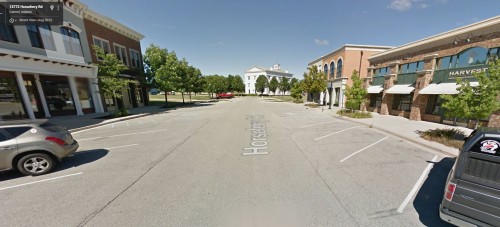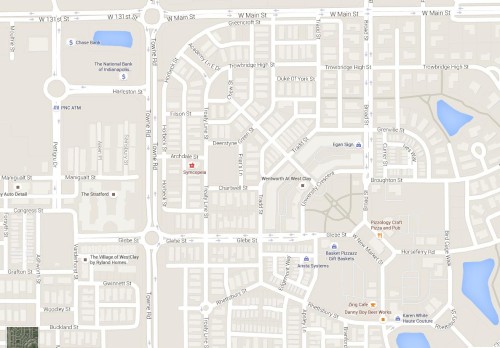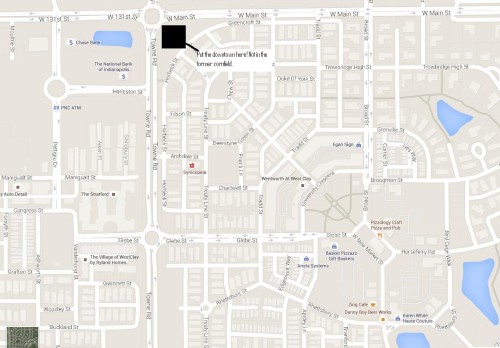Recently, the Indianapolis Business Journal’s Hamilton County Blog has posted about troubles for the Village of West Clay’s retail area. I’ve always been fascinated by this development, as it was the first greenfield development in Central Indiana that attempted to form a traditional town center under the guise of New Urbanism. Here’s the layout as seen on Google Maps:
A google Street View capture of the development’s downtown area shows what has been derided by critics as a “fake town.”

This is basically a case of getting some basics right (tree, sidewalk, and building placement for example) but missing out on the most important one: People are creatures of habit. There was an equal opportunity to build this downtown at the corner of Main and Town as there was to build a brand new one in a former cornfield:
To its credit, the IBJ’s blog mentions this glaring problem. Unfortunately for West Clay, it may be too late to change. The infrastructure is already there, well off of the main streets.
Green field development is still happening to this day. It’s survived high gas prices, a devastating recession, and mortgage crisis. It has survived nascent urban revitalization in Indianapolis as well. As long as suburbanisation is incentivized, it will remain a part of future development. So at least in this case it might be done in a way where a person can take a useful walk.
West Clay’s version of new Urbanism was basically the local development community’s first attempt at admitting that some mistakes had been made with regards to street design. I hope that future green field developers will build from the inside out, incrementally from the traditional corners of the established road network. Urban Indy still will still prefer urban revitalization over green field development for a host of reasons, but at least it would stand a better chance of being a financially sustainable development.


In my humble opinion – the lack of a true socially economically diverse make-up (homeowner base) has hindered the VWC from becoming a success. It started when they converted the apartments to condos. In all – a good attempt – but in many ways – a failed story.
I think the Village has it right, except for the commercial area which was basically a fail before it started. There’s just not enough patrons in WC to support most businesses that aren’t well-heeled enough to bleed money for 5 years or more until things pick up. Once WC delves into the “economically diverse” rabbit hole, then it’s all over. That’s when things start going down-hill rather quickly and values plummet. Condos over apartments, mean people are invested in the community, throw in the monthly HOA (higher for condos), and one must be fiscally responsible to maintain a domicile in WC. That’s a good thing. WC is wide open to a fiscally responsible, “diverse” group of owners.
I think if you look at Mueller in Austin (my new hometown), you can see it done on a much better level. Very similar to VWC (high-end row homes, some single family, garages hidden/absent, etc.). However, Mueller was smart to incorporate neighborhood strongholds like a grocery store right in the heart of it, along with the local Children’s Museum. It creates a much more lively and active neighborhood where people bike to get their groceries, and walk their kids to the park and museum. Not to mention, it’s 3 miles from downtown Austin.
To be fair, Jon, the Mueller development you site isn’t quite the same, though I suspect it IS a stronger example of New Urbanist principles than VWC. I haven’t been to Mueller, but I had to research it several years ago when working for the Urban Land Institute, so correct me if I’m wrong…
As I recall, Mueller is the repurposing of land on the former civilian airport for the Austin MSA. The closing of nearby Bergstrom AFB resulted in a shifting of commercial air serviceto the repurposed old military air field, and then Mueller closed, sat vacant, then was redeveloped into the PUD called Mueller Community. It’s not really a greenfield and didn’t require the extension of water/sewer that something like Village of West Clay would. Additionally, it’s surrounded by other long-established residential areas, some of them low-income. And, of course, you note its proximity to downtown Austin.
I’m also pretty sure that multiple parties were involved in the rezoning and development–after all, multiple parties had to be involved in the land swap that took place to relocate an airport. By contrast, VWC was driven by one developer.
I don’t think VWC is bad per say–it just has the same pros and cons as most other TNDs. The school district will always be its greatest selling point, allowing the developer to get a little complacent with some of the other design details. Conversely, Mueller is part of Austin Public Schools, so they’d have to come up with a lot of other cookies to convince families to locate in what is already a district with a mixed track record. (Besides, the general attitude toward public schools in the South is very, very different than the Midwest.)
New Urbanist greenfield development has always struck me as extremely strange. For someone who wants to enjoy the benefits of not relying on a car, living in a greenfield greenfield new urbanist development takes away much of the opportunity to do so. There is rarely public transit available, travel to any job center will be lengthy and exclusively by car. In the case of VWC, someone who works in downtown Indy would have a 45min-1hr commute one way like anyone else living nearby, but then not be able to enjoy the larger lot that typically comes with living so far out. What most would consider to be the drawback of urban living, without the typical benefits.
Indeed, all of that stuff is true. People would still likely use a car for most trips. But they wouldn’t have to use it for all trips. I guess that’s improvement?
Oddly, I got hooked on New Urbanist-style development a bit before I got hooked on the concept of urban neighborhood infill. Traditional sprawly suburban development was about all I knew as a child of Dupont Road. So, it struck me as a better way to do the thing that I was familiar with. Infill became more obvious to me simply by living and reading about Indy.
West Clay is a textbook application of New Urbanism. The very definition of New Urbanism being Seaside in the Florida Panhandle, where the term and concept was invented by Robert Davis, the founder of New Urbanism.
West Clay and Seaside are visually similar in many regards, with Seaside having the benefit of the ocean right across 30A.
In the Midwest, it’s clear that better developments are not going to be built around common areas and local shopping. That’s not what people want. In the Midwest, better developments are desired to be gated communities with limited access where people drive to shopping abundant multi-option national retail shopping.
Many of the homes in West Clay are gorgeous retro designs, but Midwesterners often prefer modern houses with a uniform appearance, driveway parking and at least two-car garages with street-facing driveways.
New Urbanism is very attractive, but it doesn’t work everywhere. Unfortunately, people take vacations in Destin and return with ideas of making Seaside work in places it shouldn’t be tried.
Urban Examiner
Indianapolis has several “streetcar suburban” neighborhoods that were “New Urbanism” before there was New Urbanism. These are Meridian Kessler, Butler Tarkington, Historic Meridian Park, Woodruff Place, and Irvington. Its one “New Urbanist” development is actually the redevelopment area of Fall Creek Place.
All have sidewalks and mature trees, some public greenspace, with churches and schools integrated into the neighborhoods. Most have commercial districts or nodes. The neighborhoods typically have alleys and rear garages, or detached rear garages, so that the neighborhood streetscape is dominated by facades with front porches instead of garage doors (like the suburbs). All are considered highly desirable by Indianapolis’ “Midwesterners”.
When West Clay was being developed, I lived in Meridian Kessler and received many mailings from its developers. I wondered why I would want to move out there. The neighborhoods I mentioned have the additional advantage of being 15-20 minutes or less from downtown by car, and only a few minutes longer by bus. The single advantage that I can see in West Clay is Carmel-Clay (public) Schools.
Does Fall Creek Place even count as new urbanist? It’s basically just rebuilding homes on the historic street grid and platting. What differentiates it from Herron Morton or Old Northside other than the ratio of old to new homes is inverted?
Modern home size and configuration, and a development that provides good auto access without featuring a streetscape of garage doors (i.e. hides parking in back) is what make FCP “New” urban.
VWC does urbanism differently than MK, Irvington, Broad Ripple, etc. The town center is designed to be away from the main street – in the case of VWC the commercial buildings should actually be on Main street, with narrowed lanes, slowed traffic (clearly College in MK and Washington in Irvington don’t get this right), and gridded streets going out in all four directions from Towne and Main.
Of course, that’s not how they did it, instead trying to create a separate town center away from any shared public space. It’s as if it’s public space intended only for those who live in VWC and never to be visited by anyone else.
It is more complicated the one getting it right one not. There is a huge difference in how Broad Ripple, MK, Irvington were developed vs VWC. THe former had thousands of different residents acting over many years on their own to build homes or businesses while the city provided some minimal infrastructure. VWC is one developer that just plopped this all down at once. In VWC’s case they did get it “wrong”. But in the others cases there really is no one to get anything wrong because there was no central directive in the first places. Also, Washington and College were turned into wide traffic sewers after the fact, the city did get this wrong.
College and Washington were wide before the car-dominated era because they had transit (streetcars and interurbans) sharing the ROW.
In fact, in the heart of old Irvington, Washington has been calmed somewhat with bump-outs protecting pedestrians and parking. Washington will change some more when/if Blue Line BRT gets built.
College will change when the Red Line BRT is put in place, as discussed in the Urban Indy post on that topic.
And this is another example of how VWC (and pretty much any other far-suburban New Urbanism development) gets urbanism wrong: transit. To the extent that Indy has transit, those neighborhoods I named are among the best-served.
Asking because I genuinely don’t know, but what speeds did street cars and interurbans travel at? I’m guessing it is less than or similar to our 35mph posted limits and much less than the actual 45-50 that most people actually travel on those arterials.
The interurbans went much faster. The city of Franklin has an interurban historical marker with facts like speeds but I’m not sure off the top of my head. I remember there was a historian at Bradford woods when I was younger that said an interurban train could get from Martinsville to downtown Indianapolis in about 30 min. So my guess would be closer to current highway speeds
“That’s not what people want. In the Midwest, better developments are desired to be gated communities with limited access where people drive to shopping abundant multi-option national retail shopping.”
It’s amazing how many gated communities you see in the Midwest. They really are absolutely everywhere you look.
Ok, I think I’m blind. Where are all of these gated communities? Cooperwood, Winterwood, Bridlebourne, Sycamore Springs, parts of Bridgewater. That’s just a few. Go to OKC or Texas. It’s like 70%.
Brendonwood (on E. 56th, between Cathedral and I-465) is now gated.
There are other communities that look gated (i.e. have a gatehouse but no gates or guard) all over the place, which at least send a subliminal message of “stay out if you don’t live here”.
This comment was pure snark on Eric’s part.
Snark based in truth, at least as far as our suburbs go. Even if they are not gated physically, they offer cues.
Urban Examiner: “That’s not what people want. In the Midwest, better developments are desired to be gated communities with limited access where people drive to shopping abundant multi-option national retail shopping.â€
Perfectly stated. WestClay is quiet. I think It needs to stay that way. If I need something, I don’t mind driving 7 minutes to a host of amenities just up 31 north to shop- I don’t even mind the construction on 31 going south; then back to quiet. I do mind the inexcusable pot holes throughout Indy though.
Urban Examiner: “The very definition of New Urbanism being Seaside in the Florida Panhandle…”
True again, 30A (seaside, alys beach, etc.) amenities aren’t far away, either way you drive on 30A. Alys Beach is the way to go in that area with it’s fierce security and room to actually breathe and less tourists. Scenic beach and grounds. Panama City Beach proper, just minutes away. Practically no one wants the area(s) built-up as opposed to maintaining the current overall Gulf Coast feel. The problem with beach property is you better be sure you can manage an ROI that you can be ok with. You don’t want to sink $6m into a well appointed money pit that only generates a pittance on a rental plan.
So technically VWC is not a gated community. Yet it’s so isolated it feels like one? Not surprised to see restaurants struggle with that location.
I think that VWC is another example of people underestimating the intensity of action/density of residents it takes in a single place to get commercial area to thrive, much less a walkable urban one. Big box stores and traditional strip development thrive off of large basins of people and stroads to get them there (and ensure they can’t walk anywhere convenient). Lots of people want the corner cafe or the corner coffee shop, but not too many people understand it takes the dense apartments and clustered housing that they oppose to support these kinds of things. A spread out single family neighborhood is not going to support the retail they have built up and there is little reason to venture into it from the outside.
Key word: density…something Indy doesn’t have yet.
And based on the continued NIMBY-ism of the residents of the central core of the city, won’t have in our lifetimes.
The increase in density in the urban core with recent construction is stunning. I think your perspective no longer reflects reality.
as I recall Interurbans were fairly fast on their own track which was typically rural, but they ran on streetcar tracks in the city. example: running on North College to Broad Ripple Av. and then”jumping the gap” and getting on the interurban track and thereafter aligning the trolley pole so they regained electricity and headed north. And, city tracks were often designed for smaller equipment, turning radius, etc. which restricted the Interurban equipment.
A little history, the VOWC had a touch and go battle when it was first proposed. The area was the county but zoning was controlled by Carmel. Mayor Brianard was fairly new in office but had different visions. The remonstrance of the area which was primarily Mini Estates didn’t want to see any retail let alone density. It was only later that Main and Town saw its first commercial buildings. Many of the residents are transplants from cities where long commutes where a way of life. With Carmel having the second largest concentration in the state of class A space and other developments on the far north side commuting could be just a few minutes. Tweaking of the zoning for retail is still going on. It’s not so much a failure but a loss of its full potential.